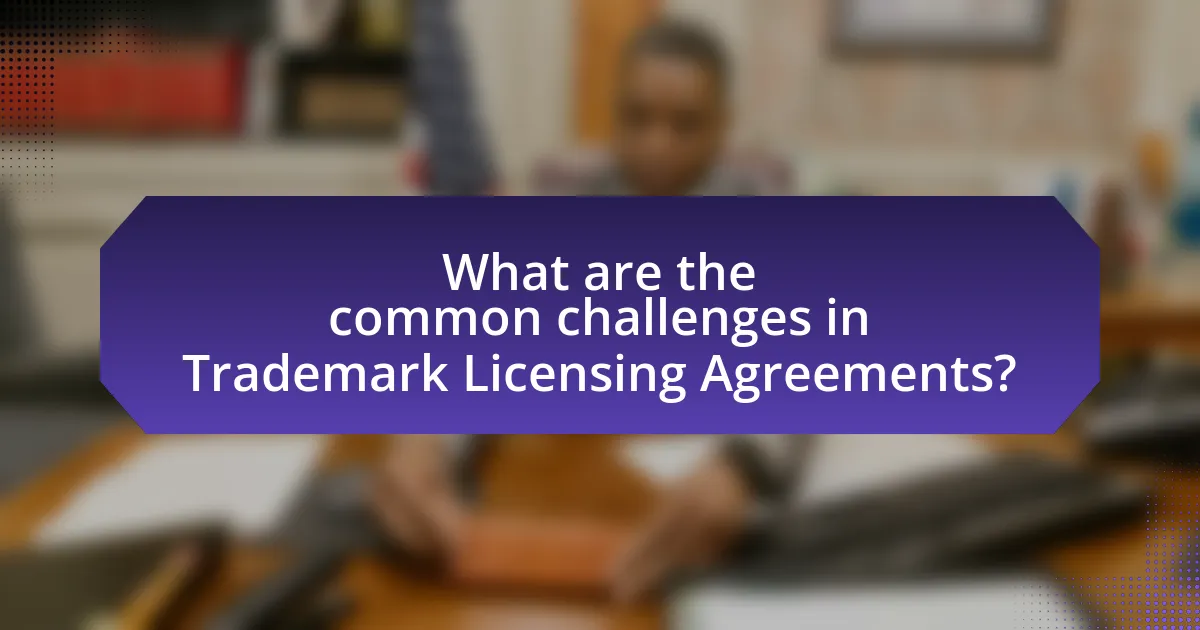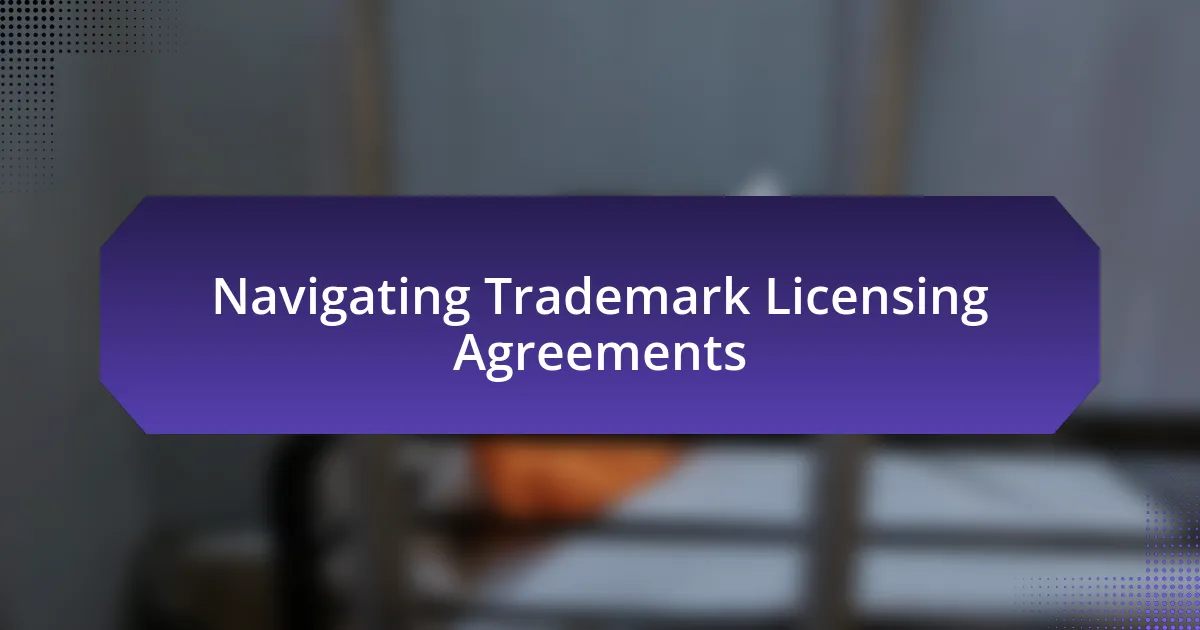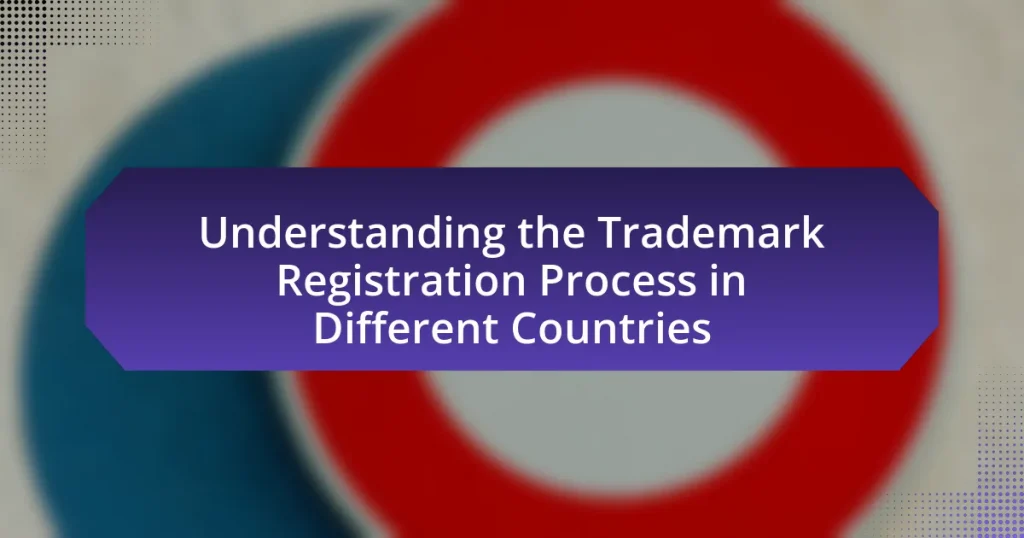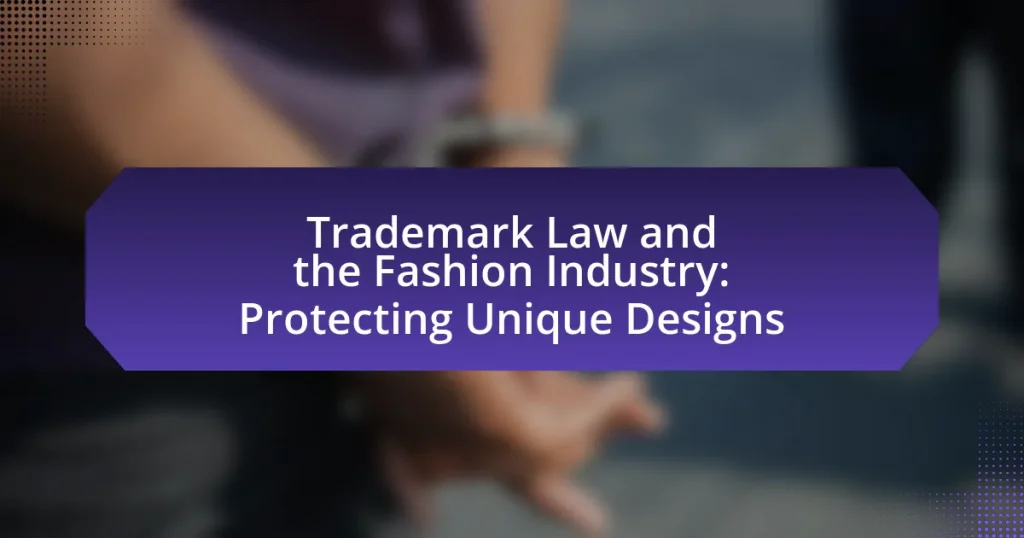Trademark licensing agreements are legal contracts that permit one party to use another party’s trademark under specific conditions, including scope, duration, and financial arrangements. This article provides a comprehensive overview of trademark licensing agreements, detailing their function, key components, types, and legal implications. It also addresses common challenges, potential risks, and best practices for negotiation and management, emphasizing the importance of clear communication and compliance to protect the interests of both licensors and licensees. Additionally, the article explores strategies for mitigating risks and ensuring fair agreements, making it a valuable resource for understanding and navigating trademark licensing.

What are Trademark Licensing Agreements?
Trademark licensing agreements are legal contracts that allow one party to use the trademark of another party under specified conditions. These agreements typically outline the scope of use, duration, and any financial arrangements, such as royalties or fees. For example, a well-known brand may license its logo to a manufacturer, enabling the manufacturer to produce and sell products featuring that logo while ensuring brand consistency and protection.
How do Trademark Licensing Agreements function?
Trademark licensing agreements function by allowing one party, the licensee, to use the trademark of another party, the licensor, under specified conditions. These agreements typically outline the scope of use, duration, territory, and any financial arrangements, such as royalties or fees. For instance, a well-known brand may license its logo to a manufacturer, enabling the manufacturer to produce and sell products featuring that logo while adhering to quality standards set by the brand. This arrangement benefits the licensor by expanding brand reach and generating revenue, while the licensee gains access to established brand recognition, which can enhance marketability.
What are the key components of a Trademark Licensing Agreement?
The key components of a Trademark Licensing Agreement include the identification of the parties involved, the scope of the license, the duration of the agreement, the territory in which the trademark can be used, quality control provisions, payment terms, and termination conditions. Each component serves a specific purpose: identifying the parties clarifies who is involved, while the scope defines how the trademark can be used. The duration specifies the time frame for the agreement, and the territory limits the geographical area of use. Quality control provisions ensure that the trademark is used consistently, payment terms outline financial obligations, and termination conditions detail how the agreement can be ended. These components are essential for protecting the rights of both the licensor and the licensee, ensuring clarity and compliance in the use of the trademark.
How do these components interact within the agreement?
The components of a trademark licensing agreement interact through defined roles, responsibilities, and terms that govern the use of the trademark. The licensor grants permission to the licensee to use the trademark under specific conditions, which include quality control measures, duration of use, and payment of royalties. These interactions ensure that the trademark’s integrity is maintained while allowing the licensee to leverage the brand for commercial gain. For instance, the licensor may require regular audits to ensure compliance with quality standards, thereby protecting the trademark’s reputation. This structured interaction is crucial for both parties to achieve their business objectives while adhering to legal requirements.
What types of Trademark Licensing Agreements exist?
There are several types of trademark licensing agreements, including exclusive licenses, non-exclusive licenses, and sole licenses. Exclusive licenses grant the licensee the sole right to use the trademark, preventing the licensor from granting further licenses to others. Non-exclusive licenses allow multiple licensees to use the trademark simultaneously, while sole licenses permit only one licensee to use the trademark, but the licensor retains the right to use it as well. These distinctions are crucial for businesses to understand their rights and obligations under trademark law.
What is the difference between exclusive and non-exclusive licenses?
Exclusive licenses grant the licensee sole rights to use the licensed material, meaning the licensor cannot grant similar rights to any other party. In contrast, non-exclusive licenses allow the licensor to grant rights to multiple licensees simultaneously. This distinction is crucial in trademark licensing agreements, as exclusive licenses often come with higher fees and greater control over the use of the trademark, while non-exclusive licenses provide broader access and potentially lower costs for multiple users.
How do territorial licenses differ from product-specific licenses?
Territorial licenses grant rights to use a trademark within a specific geographic area, while product-specific licenses provide rights to use a trademark for particular products or services regardless of location. Territorial licenses limit the scope of use based on geography, ensuring that the trademark is protected in designated regions, which can prevent market overlap and competition in those areas. In contrast, product-specific licenses focus on the type of goods or services associated with the trademark, allowing for broader distribution across various territories as long as the products fall within the defined category. This distinction is crucial for businesses to strategize their market presence and protect their intellectual property effectively.
What are the legal implications of Trademark Licensing Agreements?
Trademark licensing agreements create legal obligations between the trademark owner (licensor) and the licensee, defining how the trademark can be used. These agreements must comply with trademark law, ensuring that the licensor maintains control over the quality and nature of the goods or services associated with the trademark to avoid dilution or loss of trademark rights. Failure to adhere to these stipulations can result in legal disputes, including claims of trademark infringement or breach of contract. Additionally, the agreements must be clear on terms such as duration, territory, and compensation, as ambiguities can lead to litigation. Courts have upheld the importance of maintaining quality control in cases like “Barcamerica International USA Trust v. Tyfield Importers, Inc.,” where the lack of quality control led to the loss of trademark rights.
What are the potential risks involved in these agreements?
The potential risks involved in trademark licensing agreements include loss of control over brand reputation, financial liability, and legal disputes. Loss of control occurs when licensees fail to maintain quality standards, which can damage the brand’s image. Financial liability arises if the licensee does not meet contractual obligations, leading to potential revenue loss for the licensor. Legal disputes may occur over the interpretation of agreement terms, resulting in costly litigation. According to a study by the International Trademark Association, 30% of trademark owners reported facing disputes related to licensing agreements, highlighting the prevalence of these risks.
How can parties protect their interests in a Trademark Licensing Agreement?
Parties can protect their interests in a Trademark Licensing Agreement by clearly defining the scope of the license, including specific terms regarding usage, duration, and territory. This clarity helps prevent misunderstandings and misuse of the trademark. Additionally, parties should include quality control provisions to ensure that the licensed products or services meet certain standards, thereby maintaining the trademark’s reputation. Furthermore, incorporating termination clauses allows parties to exit the agreement if the terms are violated, safeguarding their interests. Legal precedents, such as the case of “Qualitex Co. v. Jacobson Products Co.,” demonstrate the importance of these elements in maintaining trademark integrity and protecting the rights of the trademark owner.
How can one effectively negotiate a Trademark Licensing Agreement?
To effectively negotiate a Trademark Licensing Agreement, one should focus on clearly defining the terms of use, including scope, duration, and financial arrangements. Establishing a mutual understanding of the trademark’s value and the intended market can facilitate smoother negotiations. Research indicates that successful negotiations often involve thorough preparation, including understanding the legal implications and potential risks associated with the trademark. Additionally, leveraging industry benchmarks for royalty rates can provide a solid foundation for financial discussions, ensuring that both parties feel the agreement is equitable.
What strategies can be employed during negotiations?
Effective strategies that can be employed during negotiations include preparation, active listening, and establishing clear objectives. Preparation involves researching the other party’s interests and potential concessions, which enhances the ability to propose mutually beneficial solutions. Active listening allows negotiators to understand the other party’s needs and concerns, fostering a collaborative atmosphere. Establishing clear objectives ensures that negotiators remain focused on their goals while being flexible enough to adapt to new information or proposals. These strategies are supported by negotiation theory, which emphasizes the importance of understanding both parties’ perspectives to achieve successful outcomes.
How can both parties ensure a fair agreement?
Both parties can ensure a fair agreement by engaging in transparent communication and establishing clear terms that reflect mutual interests. Transparency allows both parties to express their expectations and concerns openly, which fosters trust and reduces misunderstandings. Clear terms should include specific details about the scope of the license, duration, financial arrangements, and responsibilities of each party. According to a study published in the Journal of Intellectual Property Law & Practice, agreements that include detailed clauses and clear definitions of rights and obligations significantly reduce disputes and enhance satisfaction among parties involved.

What are the common challenges in Trademark Licensing Agreements?
Common challenges in Trademark Licensing Agreements include ensuring compliance with trademark usage standards, managing quality control, and addressing territorial restrictions. Compliance issues arise when licensees do not adhere to the agreed-upon guidelines for using the trademark, which can dilute brand value. Quality control is critical, as licensors must maintain the integrity of their brand, necessitating oversight of the licensee’s products or services. Territorial restrictions can complicate agreements, especially when licensees operate in multiple regions, leading to potential conflicts over trademark rights. These challenges can result in legal disputes, financial losses, and damage to brand reputation if not properly managed.
What disputes typically arise in Trademark Licensing Agreements?
Disputes in Trademark Licensing Agreements typically arise from issues related to the scope of the license, quality control, and royalty payments. The scope of the license can lead to disagreements over whether the licensee is operating within the agreed parameters, potentially resulting in unauthorized use of the trademark. Quality control disputes occur when licensors believe that licensees are not maintaining the standards associated with the trademark, which can damage brand reputation. Additionally, disagreements over royalty payments often arise, particularly regarding the calculation of sales and the timing of payments. These disputes can lead to legal action if not resolved amicably, highlighting the importance of clear terms in the licensing agreement.
How can misunderstandings about terms lead to conflicts?
Misunderstandings about terms can lead to conflicts by creating ambiguity in the interpretation of contractual obligations. In trademark licensing agreements, if parties do not clearly define terms such as “exclusive rights” or “territorial limits,” it can result in differing expectations regarding the use of the trademark. For instance, a licensee may assume they have broader rights than intended, leading to unauthorized use or competition with the licensor. This misalignment can escalate into legal disputes, as evidenced by cases like the 2017 dispute between the parties in the “Dawn Foods” trademark case, where vague definitions led to litigation over rights and usage. Clear definitions and mutual understanding of terms are essential to prevent such conflicts.
What role does enforcement play in resolving disputes?
Enforcement plays a critical role in resolving disputes by ensuring compliance with legal agreements and protecting the rights of the parties involved. In the context of trademark licensing agreements, enforcement mechanisms, such as litigation or arbitration, provide a structured approach to address violations, thereby maintaining the integrity of the trademark and the interests of the licensee and licensor. For instance, a study by the International Trademark Association highlights that effective enforcement can deter infringement and promote fair competition, ultimately leading to a more stable business environment.
How can parties mitigate risks in Trademark Licensing Agreements?
Parties can mitigate risks in Trademark Licensing Agreements by clearly defining the scope of the license, including specific terms regarding usage, quality control, and duration. This clarity helps prevent misunderstandings and potential disputes. Additionally, conducting thorough due diligence on the licensee’s capabilities and financial stability reduces the risk of non-compliance or failure to uphold brand standards. Implementing regular audits and monitoring compliance ensures adherence to the agreement’s terms, further safeguarding the trademark’s integrity. Historical data shows that well-structured agreements with defined parameters significantly lower the incidence of litigation, thereby protecting both parties’ interests.
What best practices should be followed during the drafting process?
During the drafting process of trademark licensing agreements, it is essential to ensure clarity and specificity in the language used. Clear definitions of terms, rights, and obligations help prevent misunderstandings and disputes. Additionally, including detailed provisions regarding the scope of the license, duration, and payment terms is crucial for establishing mutual expectations.
Moreover, incorporating compliance with relevant laws and regulations is necessary to ensure the agreement’s enforceability. For instance, the Lanham Act governs trademark use in the United States, and adherence to its provisions is vital. Regularly reviewing and updating the agreement to reflect changes in business practices or legal standards is also a best practice that helps maintain relevance and effectiveness.
How can regular reviews of the agreement help maintain compliance?
Regular reviews of the agreement help maintain compliance by ensuring that all parties adhere to the terms and conditions outlined in the trademark licensing agreement. These reviews allow for the identification of any deviations from the agreed-upon standards, enabling timely corrective actions. For instance, a study by the International Trademark Association indicates that regular compliance checks can reduce the risk of trademark infringement by up to 30%, highlighting the importance of ongoing oversight in maintaining adherence to legal obligations.

What are the best practices for managing Trademark Licensing Agreements?
The best practices for managing Trademark Licensing Agreements include establishing clear terms, conducting regular audits, and maintaining open communication. Clear terms define the scope of use, quality control measures, and financial obligations, which helps prevent disputes. Regular audits ensure compliance with the agreement and protect the trademark’s integrity, as evidenced by a study from the International Trademark Association indicating that proactive management reduces infringement risks. Open communication fosters a collaborative relationship between the licensor and licensee, allowing for timely resolution of issues and adjustments to the agreement as market conditions change.
How can effective communication enhance the management of these agreements?
Effective communication enhances the management of trademark licensing agreements by ensuring clarity, reducing misunderstandings, and fostering collaboration between parties. Clear communication allows all stakeholders to understand the terms, obligations, and expectations outlined in the agreements, which minimizes the risk of disputes. For instance, a study by the International Association for Contract and Commercial Management found that effective communication practices can lead to a 30% reduction in contract-related disputes. This reduction is crucial in maintaining positive relationships and ensuring compliance with the terms of the agreement. Additionally, regular communication facilitates timely updates and adjustments, which are essential in adapting to changing market conditions or business needs.
What tools can assist in tracking compliance and performance?
Tools that can assist in tracking compliance and performance include compliance management software, performance management systems, and audit management tools. Compliance management software, such as LogicGate or ComplyAdvantage, enables organizations to monitor adherence to regulations and internal policies effectively. Performance management systems like SAP SuccessFactors or Workday facilitate the tracking of key performance indicators (KPIs) and employee performance metrics. Audit management tools, such as AuditBoard or GRC Cloud, provide functionalities for conducting audits and ensuring compliance with licensing agreements. These tools collectively enhance visibility and accountability in managing trademark licensing agreements.
How often should parties review their Trademark Licensing Agreements?
Parties should review their Trademark Licensing Agreements at least annually. Regular annual reviews ensure that the agreements remain compliant with current laws, reflect any changes in business circumstances, and address evolving market conditions. According to the International Trademark Association, periodic reviews help identify potential issues and opportunities for renegotiation, thereby maintaining the integrity and effectiveness of the licensing arrangement.
What practical tips can help in navigating Trademark Licensing Agreements?
To effectively navigate Trademark Licensing Agreements, it is crucial to thoroughly understand the terms and conditions outlined in the agreement. This includes identifying the scope of the license, such as the geographical area, duration, and specific trademarks covered. Additionally, it is important to clarify the obligations of both parties, including quality control measures and reporting requirements.
Establishing clear communication channels between the licensor and licensee can prevent misunderstandings and facilitate smoother operations. Furthermore, consulting with legal professionals who specialize in intellectual property can provide valuable insights and help ensure compliance with relevant laws and regulations.
Research indicates that well-structured agreements that include detailed provisions on dispute resolution can significantly reduce the likelihood of conflicts, thereby enhancing the overall effectiveness of the licensing arrangement.
How can one prepare for negotiations effectively?
To prepare for negotiations effectively, one should conduct thorough research on the subject matter and the parties involved. This includes understanding the market value of the trademark, the needs and interests of both sides, and potential negotiation strategies. For instance, a study by the Harvard Business Review indicates that successful negotiators often prepare by gathering relevant data and anticipating counterarguments, which enhances their ability to reach favorable outcomes. Additionally, practicing negotiation scenarios can help in refining communication skills and building confidence, further contributing to effective preparation.
What resources are available for understanding Trademark Licensing Agreements better?
Resources for understanding Trademark Licensing Agreements include legal textbooks, online courses, and industry-specific guides. Legal textbooks such as “Trademark Licensing: Theory and Practice” provide comprehensive insights into the legal framework and practical applications of trademark licensing. Online platforms like Coursera and Udemy offer courses that cover the fundamentals and complexities of trademark law, including licensing agreements. Additionally, organizations like the International Trademark Association (INTA) publish guides and articles that detail best practices and case studies in trademark licensing, enhancing understanding through real-world examples.



